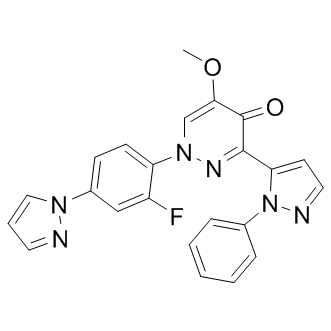
TAK-063 has potent inhibitory activity (IC50 = 0.30 nM), excellent selectivity (>15000-fold selectivity over other PDEs), and favorable pharmacokinetics, including high brain penetration, in mice.TAK-063 at 0.3 and 1 mg/kg p.o., increased cAMP and cGMP levels in the rodent striatum and upregulated phosphorylation levels of key substrates of cAMP- and cGMP-dependent protein kinases. TAK-063 at 0.3 and 1 mg/kg p.o., strongly suppressed MK-801 [(5R,10S)-(+)-5-methyl-10,11-dihydro-5H-dibenzo[a,d]cyclohepten-5,10-imine]-induced hyperlocomotion, which is often used as a predictive model for antipsychotic-like activity in rodents. Upregulation of striatal cAMP/cGMP levels and the antipsychotic-like effect of TAK-063 were not attenuated after 15 days of pretreatment with TAK-063 in mice. The potential side effect profile of TAK-063 was assessed in rats using the clinical antipsychotics haloperidol, olanzapine, and aripiprazole as controls. TAK-063 did not affect plasma prolactin or glucose levels at doses up to 3 mg/kg p.o. At 3 mg/kg p.o., TAK-063 elicited a weak cataleptic response compared with haloperidol and olanzapine.Evaluation of pathway-specific markers (substance P mRNA for the direct pathway and enkephalin mRNA for the indirect pathway) revealed that TAK-063 activated both the direct and indirect pathways of MSNs.
| Molecular Weight | 428.42 |
| Formula | C23H17FN6O2 |
| CAS Number | 1238697-26-1 |
| Solubility (25°C) | DMSO 10 mg/mL |
| Storage |
Powder -20°C 3 years ; 4°C 2 years In solvent -80°C 6 months ; -20°C 1 month |
| Species | Mouse | Rat | Rabbit | Guinea pig | Hamster | Dog |
| Weight (kg) | 0.02 | 0.15 | 1.8 | 0.4 | 0.08 | 10 |
| Body Surface Area (m2) | 0.007 | 0.025 | 0.15 | 0.05 | 0.02 | 0.5 |
| Km factor | 3 | 6 | 12 | 8 | 5 | 20 |
| Animal A (mg/kg) = Animal B (mg/kg) multiplied by | Animal B Km |
| Animal A Km |
For example, to modify the dose of Compound A used for a mouse (20 mg/kg) to a dose based on the BSA for a rat, multiply 20 mg/kg by the Km factor for a mouse and then divide by the Km factor for a rat. This calculation results in a rat equivalent dose for Compound A of 10 mg/kg.
| Related PDE Products |
|---|
| ME-3183
ME-3183 is an oral selective PDE4 inhibitor with anti-inflammatory activity for studies related to plaque psoriasis. |
| ART-648
ART-648 is a PDE4 inhibitor that may be used in studies related to non-alcoholic steatohepatitis. |
| (E/Z)-HA155
(E/Z)-HA155 is a potent Autotaxin (ATX) type I inhibitor for studies related to cancer, fibrous disorders, inflammation, pain and angiogenesis. |
| Autotaxin-IN-3
Autotaxin-IN-3 is an Autotaxin(ATX) inhibitor with an IC50 value of 2.4 nM. |
| HA155
HA155 is a potent and selective ATX inhibitor with an IC50 value of 5.7 nM. |


Products are for research use only. Not for human use. We do not sell to patients.
© Copyright 2010-2023 AbMole BioScience. All Rights Reserved.
